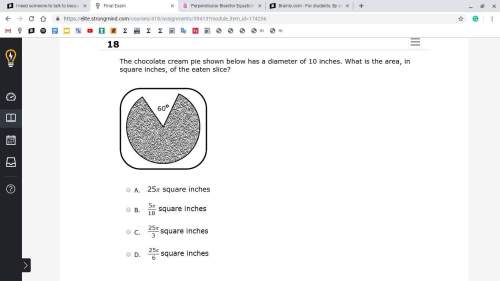
Mathematics, 27.04.2021 20:00 kordejah348
James cut out four parallelograms, the dimensions of which are shown below. Parallelogram 1 length: 12 in. width: 15 in. diagonal: 20 in. Parallelogram 2 length: 16 in. width: 30 in. diagonal: 34 in. Parallelogram 3 length: 20 in. width: 21 in. diagonal: 29 in. Parallelogram 4 length: 18 in. width: 20 in. diagonal: 26 in. James put the parallelograms together so one vertex from each paper exists on a point, as shown in the circle. 4 parallelograms are put together so that one vertex from each paper exists on a point. Which statement explains whether or not the parallelgrams can be put together so each occupies one-quarter of the area of the circle without overlapping any other pieces? Check all that apply. The quadrilaterals can be placed such that each occupies one-quarter of the circle. The quadrilaterals cannot be placed such that each occupies one-quarter of the circle because the vertices of parallelogram 1 do not form right angles. The quadrilaterals cannot be placed such that each occupies one-quarter of the circle because the vertices of parallelogram 2 do not form right angles. The quadrilaterals cannot be placed such that each occupies one-quarter of the circle because the vertices of parallelogram 3 do not form right angles. The quadrilaterals cannot be placed such that each occupies one-quarter of the circle because the vertices of parallelogram 4 do not form right angles.

Answers: 1


Other questions on the subject: Mathematics


Mathematics, 21.06.2019 12:30, pedavis6609
Abouncy ball is dropped such that the height of its first bounce is 5.5 feet and each successive bounce is 64% of the previous bounce's height. what would be the height of the 7th bounce of the ball? round to the nearest tenth (if necessary).
Answers: 2

Mathematics, 22.06.2019 01:30, gutuerrezsebastian
(01.03 mc) which of the following is a step in simplifying the expression x multiplied by y to the power of 2 over x to the power of negative 3 multiplied by y to the power of 3, the whole to the power of negative 4. select one: a. x to the power of negative 4 multiplied by y to the power of negative 2, the whole over x to the power of negative 7 multiplied by y to the power of negative 1. b. x to the power of negative 4 multiplied by y to the power of negative 8, the whole over x to the power of 12 multiplied by y to the power of negative 12. c. x to the power of negative 4 multiplied by y to the power of negative 8, the whole over x to the power of negative 3 multiplied by y to the power of 3. d. x to the power of negative 4 multiplied by y to the power of negative 2, the whole over x to the power of negative 3 multiplied by y to the power of 3.
Answers: 3
You know the right answer?
James cut out four parallelograms, the dimensions of which are shown below. Parallelogram 1 length:...
Questions in other subjects:


Physics, 13.11.2019 05:31

Mathematics, 13.11.2019 05:31



Engineering, 13.11.2019 05:31

Mathematics, 13.11.2019 05:31


History, 13.11.2019 05:31

Mathematics, 13.11.2019 05:31




